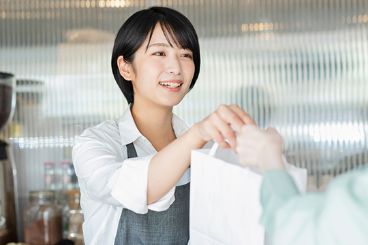Let's tackle social challenges through innovation with Epson!
Community news published with remote print. Proof of concept study of digital community development using analog media.
- A new means of delivering information was tested to help restaurants ride out the COVID-19 pandemic, increase customer satisfaction, and revitalize the local community.
- Restaurant customers were given a weekly community newsletter. The newsletter was distributed by remotely transmitting the latest news about the community and restaurant to a printer in the restaurant.
- The combination of analog and digital shows potential in drawing more people into a community by providing information that is immediately accessible and memorable.
Seiko Epson Corporation ("Epson") conducted a proof-of-concept (PoC) study to demonstrate how combining local news and remote digital printing can promote community development. Publisher Chuo Kumin Magazine and restaurants in Tokyo's Chuo Ward in Japan conducted the study. Epson planned and administered the study and provided equipment and technology. The magazine publisher provided local news stories and event information. It also generated the data for the restaurant's original community newsletter*.
* The newsletter was output on a printer in the restaurant and carried the restaurant's information, news about local events, and community information.
■Yuki Ohno (center)
Restaurant: Purana Barca
(Director, Dining Advances' Development Inc.)
■Shinji Yamashita (right)
Community newsletter production: Chief Editor of Chuo Kumin Magazine
■Masami Yamauchi (left)
Planning & administration: P Strategic Planning, Seiko Epson Corporation

Community newsletters with local information were made available for customers.
After getting through the COVID-19 pandemic, restaurants faced challenges in communicating more closely with customers and wanted a way to give back to people in the community who supported them. One solution was to distribute newsletters that diners could browse during the time between ordering and the arrival of their meal. Printing from the restaurant's printer, the newsletters would carry timely local information along with the latest news from the restaurant.
This study had three goals.
- To promote community development by providing "live" local information and the latest news from the restaurant.
- To increase customer traffic in the restaurant
- To increase customer satisfaction during lunch wait times
Two restaurants participated in the PoC study, Sakaba Diner Petit Bateau (in Nihonbashi Kobunacho) and Purana Barca (in Nihonbashi Kakigaracho). The study was divided into two four-week halves, with the first half conducted at Petit Bateau and the second half conducted at Purana Barca.
Both are busy restaurants filled with local workers and residents at lunchtime.
The process


At Petit Bateau, the newsletter was a postcard-size sheet with restaurant PR on the cover and local information on the back. The lunchtime newsletter advertised dinner, while the dinnertime newsletter advertised lunch to draw customers throughout the day.
* Postcard-size cards and A4-size clear files were placed on tables.


Purana Barca created a newsletter with a newspaper-like feel. It was formatted out like a local newspaper, with restaurant announcements mixed in with local news and event information.
* The newsletter was printed on recycled A6-size paper produced by an Epson PaperLab.

■Chuo Kumin Magazine's Shinji Yamashita (right)
■Seiko Epson Corporation's Masami Yamauchi (left)

About 1,000 newsletters were printed and distributed over the eight-week trial.
DX and SDGs are hidden behind the analog newsletters
Epson Connect was used in this PoC study to create media by remote control.
The newsletters were printed daily, on-demand, in only the number needed for that day, so there was no inventory to keep. Customers appreciated they could read timely local news. Readers could find out about events they otherwise would not have known about. They learned trivia about the city. They got valuable news and local information.
Developing an app that supports Epson Connect and allows users to select events and news according to customer attributes will make providing customized community newsletters more realistic.
Purana Barca's printed their newsletter on paper made using an Epson PaperLab papermaking system to accentuate a newspaper-like quality. The paper's unique texture offers a feel similar to straw paper or Japanese gift-wrapping paper. The unique texture is likely one of the reasons it was so well-received.
While the newsletters are distributed on analog media, they harbor the eco-conscious spirit of the SDGs and state-of-the-art digital technology.

The potential of community newsletters
We received feedback about the PoC from the two participating restaurants.
Petit Bateau
"Thank you very much for allowing us to participate in this new trial. The newsletter acts as an icebreaker, making it easier to communicate with our customers. Rather than advertising, we felt it would be better to focus more on reinvigorating the whole community."

Purana Barca
"I think the newsletter had a good balance of niche local and event information and menu recommendations. Individual customers use their smartphones while groups of customers converse as they wait for their meals to arrive. To ease the burden on our staff during busy hours, we wanted to try handing the newsletters to customers at the register as they left the restaurant."

Purana Barca
As mentioned in the feedback, the newsletters sparked organic communication between the restaurant staff and customers. This was a by-product that we hadn't thought of. This communication could boost the number of visitors to local events and draw customers back to restaurants to sample their recommended dishes.
Feedback from Chuo Kumin Magazine
This study ended just when people started becoming aware of the newsletters. There was a strong possibility that the newsletters could have produced different results if the trial had continued for longer and there had been more collaboration among members of the local community.
We were unable to verify some things with this model effectively. Still, now that restaurant traffic in March and April is reported to have recovered to pre-pandemic levels and there has been a resurgence of consumer sentiment, we would like to reevaluate this model to see how it can contribute to restaurants and communities.
Chuo Kumin Magazine https://chuo9.tokyo/ (Japanese only)
Interview conducted: March 2023
All information on organization names, affiliations, titles, and reported content was correct as of the time of the interview.



